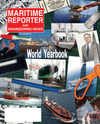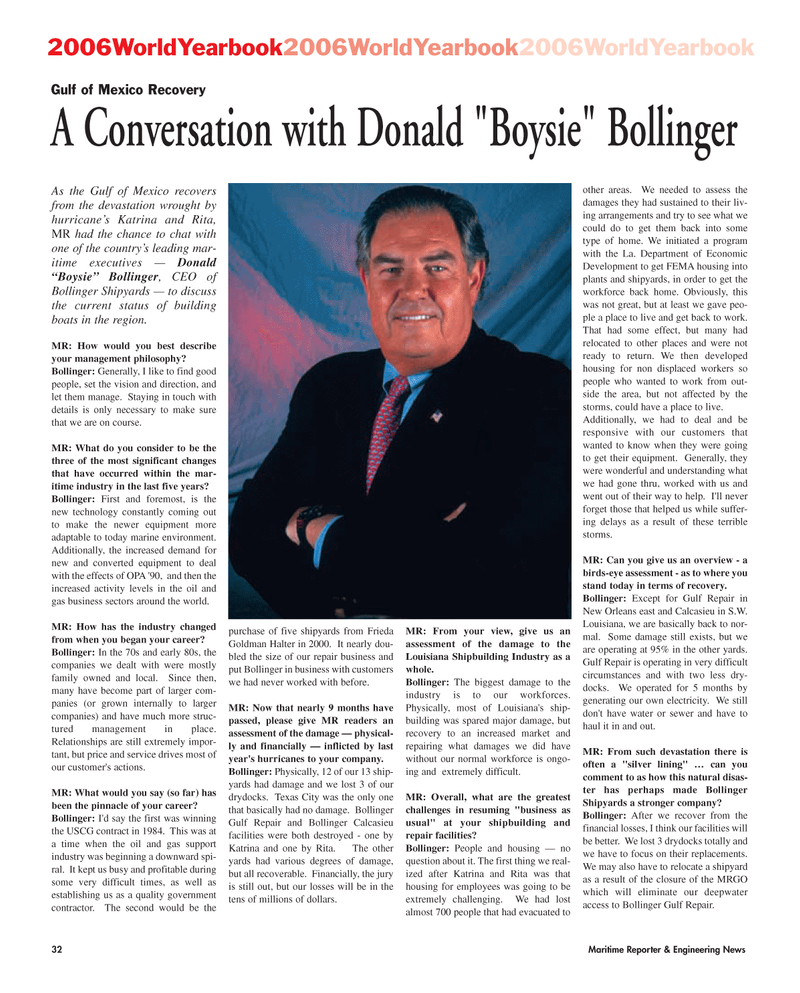
Page 32: of Maritime Reporter Magazine (June 2006)
Annual World Yearbook
Read this page in Pdf, Flash or Html5 edition of June 2006 Maritime Reporter Magazine
32 Maritime Reporter & Engineering News
As the Gulf of Mexico recovers from the devastation wrought by hurricane’s Katrina and Rita,
MR had the chance to chat with one of the country’s leading mar- itime executives — Donald “Boysie” Bollinger, CEO of
Bollinger Shipyards — to discuss the current status of building boats in the region.
MR: How would you best describe your management philosophy?
Bollinger: Generally, I like to find good people, set the vision and direction, and let them manage. Staying in touch with details is only necessary to make sure that we are on course.
MR: What do you consider to be the three of the most significant changes that have occurred within the mar- itime industry in the last five years?
Bollinger: First and foremost, is the new technology constantly coming out to make the newer equipment more adaptable to today marine environment.
Additionally, the increased demand for new and converted equipment to deal with the effects of OPA '90, and then the increased activity levels in the oil and gas business sectors around the world.
MR: How has the industry changed from when you began your career?
Bollinger: In the 70s and early 80s, the companies we dealt with were mostly family owned and local. Since then, many have become part of larger com- panies (or grown internally to larger companies) and have much more struc- tured management in place.
Relationships are still extremely impor- tant, but price and service drives most of our customer's actions.
MR: What would you say (so far) has been the pinnacle of your career?
Bollinger: I'd say the first was winning the USCG contract in 1984. This was at a time when the oil and gas support industry was beginning a downward spi- ral. It kept us busy and profitable during some very difficult times, as well as establishing us as a quality government contractor. The second would be the purchase of five shipyards from Frieda
Goldman Halter in 2000. It nearly dou- bled the size of our repair business and put Bollinger in business with customers we had never worked with before.
MR: Now that nearly 9 months have passed, please give MR readers an assessment of the damage — physical- ly and financially — inflicted by last year's hurricanes to your company.
Bollinger: Physically, 12 of our 13 ship- yards had damage and we lost 3 of our drydocks. Texas City was the only one that basically had no damage. Bollinger
Gulf Repair and Bollinger Calcasieu facilities were both destroyed - one by
Katrina and one by Rita. The other yards had various degrees of damage, but all recoverable. Financially, the jury is still out, but our losses will be in the tens of millions of dollars.
MR: From your view, give us an assessment of the damage to the
Louisiana Shipbuilding Industry as a whole.
Bollinger: The biggest damage to the industry is to our workforces.
Physically, most of Louisiana's ship- building was spared major damage, but recovery to an increased market and repairing what damages we did have without our normal workforce is ongo- ing and extremely difficult.
MR: Overall, what are the greatest challenges in resuming "business as usual" at your shipbuilding and repair facilities?
Bollinger: People and housing — no question about it. The first thing we real- ized after Katrina and Rita was that housing for employees was going to be extremely challenging. We had lost almost 700 people that had evacuated to other areas. We needed to assess the damages they had sustained to their liv- ing arrangements and try to see what we could do to get them back into some type of home. We initiated a program with the La. Department of Economic
Development to get FEMA housing into plants and shipyards, in order to get the workforce back home. Obviously, this was not great, but at least we gave peo- ple a place to live and get back to work.
That had some effect, but many had relocated to other places and were not ready to return. We then developed housing for non displaced workers so people who wanted to work from out- side the area, but not affected by the storms, could have a place to live.
Additionally, we had to deal and be responsive with our customers that wanted to know when they were going to get their equipment. Generally, they were wonderful and understanding what we had gone thru, worked with us and went out of their way to help. I'll never forget those that helped us while suffer- ing delays as a result of these terrible storms.
MR: Can you give us an overview - a birds-eye assessment - as to where you stand today in terms of recovery.
Bollinger: Except for Gulf Repair in
New Orleans east and Calcasieu in S.W.
Louisiana, we are basically back to nor- mal. Some damage still exists, but we are operating at 95% in the other yards.
Gulf Repair is operating in very difficult circumstances and with two less dry- docks. We operated for 5 months by generating our own electricity. We still don't have water or sewer and have to haul it in and out.
MR: From such devastation there is often a "silver lining" … can you comment to as how this natural disas- ter has perhaps made Bollinger
Shipyards a stronger company?
Bollinger: After we recover from the financial losses, I think our facilities will be better. We lost 3 drydocks totally and we have to focus on their replacements.
We may also have to relocate a shipyard as a result of the closure of the MRGO which will eliminate our deepwater access to Bollinger Gulf Repair. 2006WorldYearbook2006WorldYearbook2006WorldYearbook
Gulf of Mexico Recovery
A Conversation with Donald "Boysie" Bollinger
MR JUNE2006 #4 (25-32).qxd 6/2/2006 11:05 AM Page 32

 31
31

 33
33
